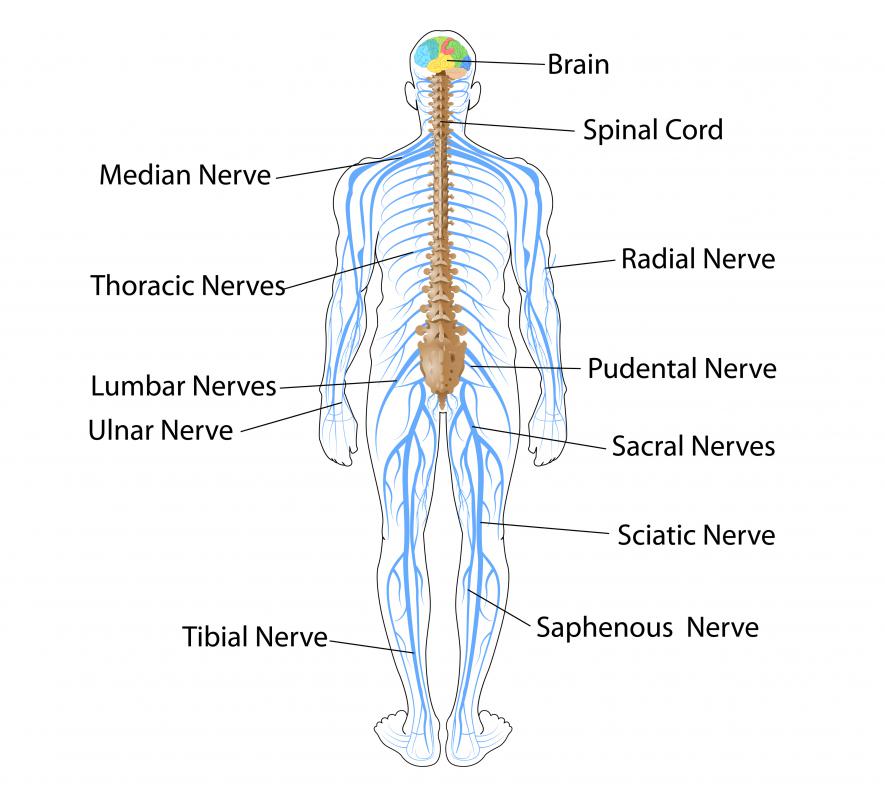At WiseGEEK, we're committed to delivering accurate, trustworthy information. Our expert-authored content is rigorously fact-checked and sourced from credible authorities. Discover how we uphold the highest standards in providing you with reliable knowledge.
What is CNS Vasculitis?
Blood vessel inflammation that affects the brain and spinal cord is known as CNS (central nervous system) vasculitis. A condition that induces structural changes to the walls of the affected blood vessels, CNS vasculitis may occur as a primary angiitis, or vasculitis, of the central nervous system (PACNS) or in a milder form referred to as benign angiopathy of the central nervous system (BACNS). Treatment for central nervous system vasculitis is dependent on the form the condition adopts.
There is no single, known cause for most cases of central nervous system vasculitis. Idiopathic cases, or those with an unknown origin, are commonly referred to as primary vasculitis. When a correlation is made between CNS development and an underlying condition, such as an infection, allergic reaction, systemic disease, or cancer, it is referred to as secondary vasculitis. It has been asserted that the presence of a viral infection may contribute to the inflammatory processes associated with the development of CNS vasculitis.

Clinically speaking, there is no difference between PACNS and BACNS when it comes to symptom manifestation. Individuals with CNS vasculitis experience predominantly neurological symptoms similar to those associated with a stroke that may include headache, confusion and memory deficits, and seizure. Additional symptoms may include vision problems and localized bleeding within the central nervous system. Individuals with a diagnosis of PACNS have a form of CNS vasculitis that adversely affects both small and medium sized blood vessels and is confined to the central nervous system. Those with BACNS are diagnosed with a milder form of CNS vasculitis referred to as reversible vasoconstrictive disease, which is characterized by blood vessel constriction and spasms.

Since many of the manifestations of CNS vasculitis mimic characteristics associated with other conditions, extensive testing is necessary to support a diagnosis. Individuals may undergo a variety of tests that may include magnetic resonance imaging (MRI) tests, lumbar punctures (spinal taps), and an angiogram of the brain. Results that indicate the presence of aneurysms, a narrowing and dilation of the blood vessels, or any other anomalies within the brain may be utilized to support a diagnosis of CNS vasculitis.

In some cases, individuals may need to undergo a biopsy to confirm a diagnosis of CNS vasculitis. A brain biopsy involves removing sample tissue and cells from the brain and the thin membranes covering the brain, known as the meninges. The biopsy is usually conducted on the individual’s less-dominant side, meaning if he or she is right-handed, or left-brained, the biopsy will be conducted on the right side of the brain.

Treatment for individuals diagnosed with a PACNS form of vasculitis involves the use of immunosuppressive therapy over the course of a year or more. Individuals with this type of blood vessel inflammation may be given high doses of steroidal medications. Those who undergo immunosuppressive therapy should have routine urinalyses and blood counts conducted. In some cases, if the individual does not respond well to the administration of steroidal drugs, he or she may be given cyclophosphamide, a drug commonly prescribed to inhibit the body's immuno-response to certain inflammatory conditions. Side effects may include weight gain, blood sugar fluctuation, and an increased risk for developing infection.
Individuals with BACNS may be treated with calcium-channel blockers over a short-term period, generally a few weeks. Following the discontinuation of calcium-channel blockers, steroidal medications may be administered for an additional few weeks. Calcium-channel blockers and steroidal medications are used to regulate blood pressure and alleviate inflammation. Treatment approach and composition for BACNS is wholly dependent on the individual and his or her overall medical situation.
AS FEATURED ON:
AS FEATURED ON:














Discussion Comments
Have you ever treated anyone with CNS vasculitis?
Post your comments